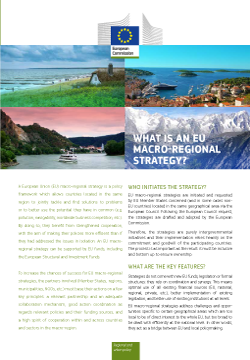What is an EU macro-regional strategy?

Factsheets
Date: 15 dec 2017
Theme: Business support, Culture, Energy, Environment, EU Strategy for the Baltic Sea Region, EU Strategy for the Danube Region, Tourism, Transport, Urban development, Research and innnovation, EU Strategy for the Adriatic and Ionian Region, Social inclusion, Jobs, Education and Training, EU Strategy for the Alpine Region
Languages: bg | cs | da | de | el | en | et | fi | fr | hr | hu | it | lt | lv | pl | ro | sk | sl | sv
A European Union (EU) macro-regional strategy is a policy framework which allows countries located in the same region to jointly tackle and find solutions to problems or to better use the potential they have in common (e.g. pollution, navigability, worldwide business competition, etc.). By doing so, they benefit from strengthened cooperation, with the aim of making their policies more efficient than if they had addressed the issues in isolation. An EU macroregional strategy can be supported by EU funds, including the European Structural and Investment Funds.
To increase the chances of success for EU macro-regional strategies, the partners involved (Member States, regions, municipalities, NGOs, etc.) must base their actions on a few key principles: a relevant partnership and an adequate collaboration mechanism, good action coordination as regards relevant policies and their funding sources, and a high spirit of cooperation within and across countries and sectors in the macro-region.
